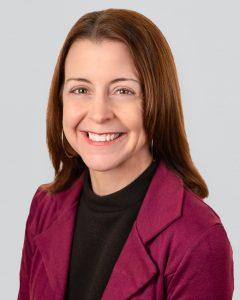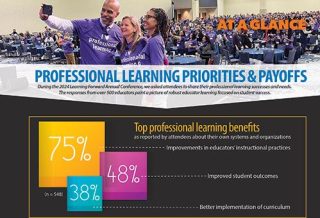FOCUS
Success stories highlight how educators can pivot
By Suzanne Bouffard
Categories: Change management, Data, Instructional materials/curriculumAugust 2024
Whenever I hear the word “pivot,” I think of a move that’s common in many dance forms. You put your foot forward and push off of it to turn your body. A pivot can be a quarter turn or a half turn, but not a full turn. You end up facing a new direction, positioned to move toward a new location. Whether dancers or not, we all make metaphorical pivots from time to time — notable changes in direction that require putting a foot forward and ending up somewhere new. Often, we pivot because new information tells us that what we’re doing isn’t working or that there’s a better way.
In education, that information can take the form of student data, new research on instructional practices, or intentional reflection on the outcomes of past efforts. The need to pivot can also come from changes in our environments. It’s hard to think of a more significant pivot than the one necessitated by the physical and social changes wrought by the COVID-19 pandemic.
A dancer’s pivot is a basic step that’s easy to execute; an educator’s is not. In education, it takes investments in adults’ learning to understand, initiate, evaluate, and recalibrate change strategies. That’s why we have dedicated this issue ofThe Learning Professional to learning to pivot.
When what we’re doing isn’t working, we must pivot. This issue of #TheLearningPro explores how new information, such as student data or current research on instructional practices, leads educators to make changes. Share on XArticles look at the what, why, and how of many kinds of pivots, including adapting to the reality of AI in schools, restructuring summer programs, and rethinking approaches to reducing racial disparities in school discipline. A special section focuses on how professional learning is supporting schools to shift to science-based methods of reading instruction, one of schools’ current highest-priority pivots. Around the U.S. and beyond, leaders are stressing the urgency of changes in literacy approaches based on alarming statistics about children’s low reading skills.
In the U.S., nearly 40% of 4th graders scored below basic on the 2022 National Assessment of Educational Progress (NAEP, 2022). As a result, in recent years, 34 states and the District of Columbia have passed policies or regulations requiring that teachers engage in professional learning about the science of reading. (For more information, see p. 85.)
Those policies are encouraging, but to make real change, they must ensure that professional learning is high-quality and aligned to Standards for Professional Learning (Learning Forward, 2022). A one-time workshop or a boxed curriculum without ongoing support is not going to lead to improvements for students, as authors in this issue of The Learning Professional know. They describe how their schools, districts, and states are leveraging coaching, job-embedded residencies, leadership development, and online learning to improve educators’ literacy practices and close gaps in students’ reading proficiency.
The issue also includes tools for helping manage change, and Frederick Brown, Learning Forward’s president and CEO, revisits the learning team cycle and shows how it can help educators make shifts both minor and major.
With this issue, we’re also doing some pivoting of our own to make the research section as useful to you as possible. As a result of feedback from you, Elizabeth Foster’s column will have a broader focus, including evaluation, research tools, and methods and mechanisms for studying your efforts and their impact. We encourage you to send your ideas and questions to shape future issues.
Pivoting can be disorienting, especially when it takes you in a direction you’ve never faced before. But when you step forward with a clear focus and strong support, you can turn smoothly, ready to glide into your next move.
Download pdf here.
References
Learning Forward (2022). Standards for Professional Learning. Author.
NAEP. (2022). NAEP reading assessment: Highlights. bit.ly/3zSOrpb

Suzanne Bouffard is senior vice president of communications and publications at Learning Forward. She is the editor of The Learning Professional, Learning Forward’s flagship publication. She also contributes to the Learning Forward blog and webinars. With a background in child development, she has a passion for making research and best practices accessible to educators, policymakers, and families. She has written for many national publications including The New York Times and the Atlantic, and previously worked as a writer and researcher at the Harvard Graduate School of Education. She has a Ph.D. in developmental psychology from Duke University and a B.A. from Wesleyan University. She loves working with authors to help them develop their ideas and voices for publication.
Categories: Change management, Data, Instructional materials/curriculum
Recent Issues
LEARNING DESIGNS
February 2025
How we learn influences what we learn. This issue shares essential...
BUILDING BRIDGES
December 2024
Students benefit when educators bridge the continuum of professional...
CURRICULUM-BASED PROFESSIONAL LEARNING
October 2024
High-quality curriculum requires skilled educators to put it into...
LEARNING TO PIVOT
August 2024
Sometimes new information and situations call for major change. This issue...












